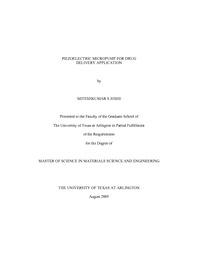
ATTENTION: The works hosted here are being migrated to a new repository that will consolidate resources, improve discoverability, and better show UTA's research impact on the global community. We will update authors as the migration progresses. Please see MavMatrix for more information.
Show simple item record
| dc.contributor.author | Joshi, Miteshkumar Sureshchandra | en_US |
| dc.date.accessioned | 2007-08-23T01:56:25Z | |
| dc.date.available | 2007-08-23T01:56:25Z | |
| dc.date.issued | 2007-08-23T01:56:25Z | |
| dc.date.submitted | August 2005 | en_US |
| dc.identifier.other | DISS-1089 | en_US |
| dc.identifier.uri | http://hdl.handle.net/10106/285 | |
| dc.description.abstract | Bending type actuators providing high displacement (~1mm) with low blocking force (~0.5N) and the stack actuators providing low displacement (~1m) with high blocking force (~1kN) represent the extreme ends of the current piezoelectric actuation technology. In the intermediate range there is deficiency of the actuator designs that provide high displacement with high blocking force in low frequency range of ~2 kHz. This thesis addresses this issue and describes a metal-ceramic actuator design that exhibits high displacement with high blocking force. The structure consist of a piezoelectric bar poled along the length and metal caps were attached to the two opposite major faces of the bar bounded by steel blocks. The piezoelectric bar is multilayered for operating at low driving voltages. Extensive FEM analysis using ATILA was conducted to optimize the dimensions of the actuator. FEM results showed that the flextensional mode for actuator of dimension 7x7x40 mm3 occurs at low frequency of 2.175 kHz. The maximum displacement of about 15 m was found at driving voltage of 8.5 V. It was observed that by changing the actuator parameters, cavity depth and cap thickness the resonance frequency can be shifted to desired frequency range. These numbers showed that as an actuator, the proposed design has the potential for meeting the high displacement - high blocking force requirement in the low frequency range. Based on FEM analysis the optimized actuator design was fabricated. A PZT based composition corresponding to 0.98Pb(Zr0.52Ti0.48)O3 + 0.01Nb2O5 + 0.01PbO was synthesized to fabricate the active actuation component. The fabricated actuator was characterized for impedance, piezoelectric constant and displacement. The results were found to be consistent with the FEM analysis. As an application this actuator was found suitable for micropump for being used in the controlled drug delivery application. The piezoelectric actuator is used to drive the micropump. Piezoelectric driving mechanism is suitable in this application because it has fast response and operates at low voltages. The designed pump is a valveless diffuser/nozzle pump. It utilizes the property of diffuser that it has less restriction to flow in one direction than in the nozzle direction. The pump operates in two modes: Pump mode and Supply mode. The characteristics of the pump can be controlled by changing either the applied voltage or the input frequency. | en_US |
| dc.description.sponsorship | Priya, Shashank | en_US |
| dc.language.iso | EN | en_US |
| dc.publisher | Materials Science & Engineering | en_US |
| dc.title | Piezoelectric Micropump For Drug Delivery Application | en_US |
| dc.type | M.S.Mat.S.E. | en_US |
| dc.contributor.committeeChair | Priya, Shashank | en_US |
| dc.degree.department | Materials Science & Engineering | en_US |
| dc.degree.discipline | Materials Science & Engineering | en_US |
| dc.degree.grantor | University of Texas at Arlington | en_US |
| dc.degree.level | masters | en_US |
| dc.degree.name | M.S.Mat.S.E. | en_US |
Files in this item
- Name:
- umi-uta-1089.pdf
- Size:
- 2.568Mb
- Format:
- PDF
This item appears in the following Collection(s)
Show simple item record


